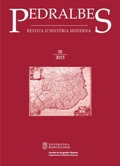Un panegírico para el sultán Solimán: nueva aproximación al Sulaimānnāma como fuente histórica
Keywords:
Sultan Süleyman the Magnificent, Ottoman Court, Süleymanname, shehnāmeci, Fethullah Çelebi, ‘Arif, Shahnama, Shahnama-yi Al-i Osman, Prince Mustafa.Abstract
In this article I discuss the potential of the Sulaimānnāma, a work well known in name but not studied comprehensively or in depth, as an historical source to understand better the reign of Sultan Süleyman (r. 1520-1566). I aim to cast aside the prejudice caused both by its sophisticated literary language and the general designation of the work as a panegyric, and display some of the ways in which shehnāmeci ‘Arif’s work could be useful for research in cultural and
political history.
Sulaimānnāma is neither a mere panegyric nor a straight forward history of the sultan’s reign. Both the presence of particular versions of disputed stories, such as that of the execution of Prince Mustafa, and the disproportionate amount of information on the workings of the state and the ceremonial suggest that it was intended as a document that the palace wanted to pass on to future generations as a memorial as well as a model for emulation. Hence, studying this multifaceted source can help us decipher the messages that Sultan Süleyman and the leading members of his court wanted to project, and gain insight into the cultural and political environment that its text and images reflect.
Downloads
Published
How to Cite
Issue
Section
License
Copyright (c) 2015 Fatma Sinem Eryılmaz

This work is licensed under a Creative Commons Attribution-ShareAlike 4.0 International License.
Authors must agree with the following terms:
1. The author keeps authorship rights, ceding the journal the right to first publication.
2. Texts will be disseminated with a Creative Commons Attribution 4.0 International License. Which allows for the work to be shared with third parties, as long as they recognise the work’s authorship, the original publication in the journal and licensing conditions.
This requires acknowledging authorship appropriately, providing a link to the license, and indicating if any changes have been made. It can be indicated in any reasonable way, but not in a manner that suggests the licensor endorses or sponsors the use of the text.
If content is remixed, transformed, or new content is created from the journal's texts, it must be distributed under the same license as the original text



